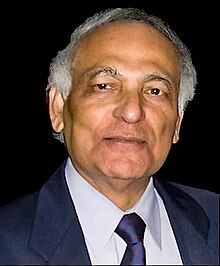Bibudhendra Sarkar – Wikipedia
|
Bibudhendra Sarkar |
|
|---|---|

Bibudhendra (Amu) Sarkar, The Hospital for Sick Children and University of Toronto |
|
| Born | August 2, 1935 |
| Nationality | Canadian |
| Citizenship | Canada |
| Alma mater | Calcutta University (Matriculation & I.Sc.) Banaras Hindu University (B.Pharm. & M.Pharm.) University of Southern California, USA (Ph.D.) |
| Known for | Inventor of Menkes disease treatment by copper-histidine ATCUN motif of proteins Toxic metals in water A pioneer in Inorganic Biochemistry |
| Spouse | Dipti Sarkar (née Dutt) (b. 1944 – d. 1985) |
| Children | Utpaul (Paul) Sarkar, Urmila (Uma) Sarkar |
| Scientific career | |
| Fields | |
| Institutions | Hospital For Sick Children and University of Toronto |
| Thesis | Studies on the transport, metabolism and chemistry of iron-sugar chelates (1964) |
| Doctoral advisor | Paul Saltman |
Bibudhendra (Amu) Sarkar (born August 2, 1935) is a Canadian biochemist best known for his research on copper-histidine in human blood, leading to the first treatments for Menkes Disease. He served as head of the Division of Biochemistry Research at the Sick Kids Research Institute in Toronto from 1990-2002, where he established the Department of Structural Biology Research in 1990[1].
Early life and education[edit]
Bibudhendra (Amu) Sarkar was born on August 2, 1935 in Kushtia, Bengal, British India (now Bangladesh)[2][3]. His father, Surendra Nath Sarkar, was a lawyer and mother, Sucheta Sarkar (née Chaki), a homemaker who died when he was one year old[2]. He attended Kushtia Mission School, a Catholic school for his kindergarten and primary education[2].
A horrific aftermath followed the partition of India and Pakistan in 1947 with communal violence. His family was forced to leave behind everything they possessed and migrated to Calcutta (now Kolkata) for their safety[2]. He studied in City College School and City College, Kolkata[2]. He obtained his Matriculation and Intermediate Science Certification from the University of Calcutta[3][4]. He then enrolled in the Banaras Hindu University (BHU), a residential University located near the ancient holy city of Varanasi, Uttar Pradesh[2]. He received B. Pharm and M. Pharm degrees specializing in the chemistry of natural products[2]. During his studies in BHU he was a regular summer student in the Central Drug Research Institute in Lucknow where he was mentored by Dr. Manojit Mohan (Babul) Dhar[2]. Dhar had a profound influence on Sarkar’s future career. It was Dhar who encouraged Sarkar to do his graduate studies in a top University in the USA or Europe[2]. Sarkar then travelled to the USA to do his graduate studies in Biochemistry in the University of Southern California (USC), Los Angeles, under the supervision of Paul Saltman. It was in Saltman’s laboratory he started to become a biochemist – with a new twist: “Inorganic Biochemist”, a term which had yet to be invented[2]. Sarkar was highly influenced by several eminent scientists while at USC: Sydney Benson in Chemical Kinetics, Arthur Adamson in Physical Chemistry and Bo Malmström in Metal-Activated Enzyme Chemistry[2]. Sarkar graduated with a PhD degree in Biochemistry in 1964[2][5].
In early 1964 Sarkar was presenting his PhD work at the Federation of American Societies for Experimental Biology (FASEB) meeting in Chicago where Dr. Andrew Sass-Kortsak, a clinician specialist in Wilson’s disease at the Hospital for Sick Children in Toronto, Canada came to listen to his lecture[2][6]. Sass-Kortsak was leading the Genetic Metabolic Program of the Hospital for Sick Children and he was there looking for a young basic scientist to join in his program as a Staff Scientist[2][6]. Sass-Kortsak invited Sarkar to Toronto to give a seminar on his work. To Sarkar’s great surprise, on the same day he was offered a Staff Scientist’s position in the Genetic Metabolic Research Program with start-up funds and his own laboratory in a newly built wing in SickKids[2]. Sass-Kortsak also took him on a tour to show his patients in the wards[2]. Sarkar decided to join the Research Institute of SickKids at the age of 29 being the first basic scientist recruited by SickKids in 1964[6]. Soon thereafter he was cross-appointed to the Department of Biochemistry at the University of Toronto[1].
Sass-Kortsak’s vast experience in clinical medicine and Wilson’s disease opened a new horizon for Sarkar, a niche where he could apply his basic biochemistry knowledge to solve medical problems. Sarkar began attending Grand Rounds with Sass-Kortsak and went to the wards to visit Wilson’s disease patients[2]. Because of his interest in the biophysical aspects of metal protein interactions and metal transport, Sarkar’s research turned to metal-related diseases. He pioneered multidisciplinary research in SickKids in association with Sass-Kortsak by crossing the boundaries between basic science and clinical medicine and creating a collaborative environment in SickKids[6]. In 1990 he was appointed Head of the Division of Biochemistry…
Read More: Bibudhendra Sarkar – Wikipedia

